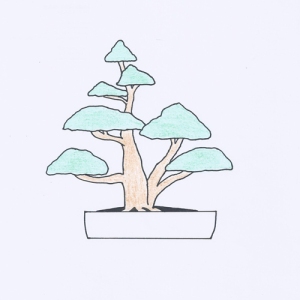Sokan style, or twin-trunk Bonsai has two trunks rising from the root system, or nebari. The trunks may split immediately above the roots, or rise as one from the soil and then split after a few inches.
The perfect and most sought-after Sokan Bonsai has one trunk taller and thicker than the other, with both trunks being visible when viewed from the front of the pot/tree. The branch positions, working around both trunks, should be as follows: left, right and back. There should not be any branches pointing from one trunk to the other.
Many Bonsai enthusiasts love the Sokan style as it gives the grower a chance to work with two trees, sometimes making a great piece from two trees that wouldn’t otherwise have made great Bonsai on their own terms.
You could imagine this style of Bonsai to be like creating a ‘marriage’. The larger tree is the male, carefully and lovingly protecting his wife from the harsh elements by shading her and gently arching over her. Ultimately the apex of both trees will meet to form one – and when creating correctly, this can be an absolutely stunning composition.
Care must be taken when creating Sokan style Bonsai, especially where the back branches and the roots are concerned. There will be an empty void between the two trunks that will require filling with suitable back branches, if not the grower will have created an empty void that will detract from the composition.
Another feature that may happen if the tree is left to grow unchecked is a reverse taper rising from the nebari (root system). This can easily happen due to the twin trunk effect, so the roots will need due care and attention to ensure they remain exposed and the taper is clearly evident at the tree’s base








Well written Molly!
ReplyDeleteSimple n clear
ReplyDelete